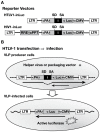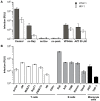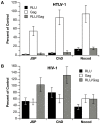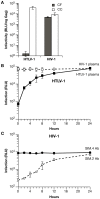Quantitative comparison of HTLV-1 and HIV-1 cell-to-cell infection with new replication dependent vectors
- PMID: 20195464
- PMCID: PMC2829072
- DOI: 10.1371/journal.ppat.1000788
Quantitative comparison of HTLV-1 and HIV-1 cell-to-cell infection with new replication dependent vectors
Abstract
We have developed an efficient method to quantify cell-to-cell infection with single-cycle, replication dependent reporter vectors. This system was used to examine the mechanisms of infection with HTLV-1 and HIV-1 vectors in lymphocyte cell lines. Effector cells transfected with reporter vector, packaging vector, and Env expression plasmid produced virus-like particles that transduced reporter gene activity into cocultured target cells with zero background. Reporter gene expression was detected exclusively in target cells and required an Env-expression plasmid and a viral packaging vector, which provided essential structural and enzymatic proteins for virus replication. Cell-cell fusion did not contribute to infection, as reporter protein was rarely detected in syncytia. Coculture of transfected Jurkat T cells and target Raji/CD4 B cells enhanced HIV-1 infection two fold and HTLV-1 infection ten thousand fold in comparison with cell-free infection of Raji/CD4 cells. Agents that interfere with actin and tubulin polymerization strongly inhibited HTLV-1 and modestly decreased HIV-1 cell-to-cell infection, an indication that cytoskeletal remodeling was more important for HTLV-1 transmission. Time course studies showed that HTLV-1 transmission occurred very rapidly after cell mixing, whereas slower kinetics of HIV-1 coculture infection implies a different mechanism of infectious transmission. HTLV-1 Tax was demonstrated to play an important role in altering cell-cell interactions that enhance virus infection and replication. Interestingly, superantigen-induced synapses between Jurkat cells and Raji/CD4 cells did not enhance infection for either HTLV-1 or HIV-1. In general, the dependence on cell-to-cell infection was determined by the virus, the effector and target cell types, and by the nature of the cell-cell interaction.
Conflict of interest statement
The authors have declared that no competing interests exist.
Figures






Similar articles
-
Improvement of HIV-1 and Human T Cell Lymphotropic Virus Type 1 Replication-Dependent Vectors via Optimization of Reporter Gene Reconstitution and Modification with Intronic Short Hairpin RNA.J Virol. 2015 Oct;89(20):10591-601. doi: 10.1128/JVI.01940-15. Epub 2015 Aug 12. J Virol. 2015. PMID: 26269177 Free PMC article.
-
The Tax-Inducible Actin-Bundling Protein Fascin Is Crucial for Release and Cell-to-Cell Transmission of Human T-Cell Leukemia Virus Type 1 (HTLV-1).PLoS Pathog. 2016 Oct 24;12(10):e1005916. doi: 10.1371/journal.ppat.1005916. eCollection 2016 Oct. PLoS Pathog. 2016. PMID: 27776189 Free PMC article.
-
Examining human T-lymphotropic virus type 1 infection and replication by cell-free infection with recombinant virus vectors.J Virol. 2001 Sep;75(18):8461-8. doi: 10.1128/jvi.75.18.8461-8468.2001. J Virol. 2001. PMID: 11507191 Free PMC article.
-
Cell-Free versus Cell-to-Cell Infection by Human Immunodeficiency Virus Type 1 and Human T-Lymphotropic Virus Type 1: Exploring the Link among Viral Source, Viral Trafficking, and Viral Replication.J Virol. 2016 Aug 12;90(17):7607-17. doi: 10.1128/JVI.00407-16. Print 2016 Sep 1. J Virol. 2016. PMID: 27334587 Free PMC article. Review.
-
Molecular and cellular interactions of HIV-1/HTLV coinfection and impact on AIDS progression.AIDS Rev. 2007 Jul-Sep;9(3):140-9. AIDS Rev. 2007. PMID: 17982939 Review.
Cited by
-
Restriction of diverse retroviruses by SAMHD1.Retrovirology. 2013 Mar 5;10:26. doi: 10.1186/1742-4690-10-26. Retrovirology. 2013. PMID: 23497255 Free PMC article.
-
HTLV-1 Hbz protein, but not hbz mRNA secondary structure, is critical for viral persistence and disease development.PLoS Pathog. 2023 Jun 16;19(6):e1011459. doi: 10.1371/journal.ppat.1011459. eCollection 2023 Jun. PLoS Pathog. 2023. PMID: 37327244 Free PMC article.
-
Recent Insights into the HIV/AIDS Pandemic.Microb Cell. 2016 Sep 5;3(9):451-475. doi: 10.15698/mic2016.09.529. Microb Cell. 2016. PMID: 28357381 Free PMC article. Review.
-
Investigating the correlation between prominent viruses and hematological malignancies: a literature review.Med Oncol. 2024 Mar 28;41(5):102. doi: 10.1007/s12032-024-02345-1. Med Oncol. 2024. PMID: 38546893 Review.
-
Neutralization and spike stability of JN.1-derived LB.1, KP.2.3, KP.3, and KP.3.1.1 subvariants.mBio. 2025 May 14;16(5):e0046425. doi: 10.1128/mbio.00464-25. Epub 2025 Mar 26. mBio. 2025. PMID: 40136024 Free PMC article.
References
-
- Phillips DM. The role of cell-to-cell transmission in HIV infection. Aids. 1994;8:719–731. - PubMed
Publication types
MeSH terms
Grants and funding
LinkOut - more resources
Full Text Sources
Other Literature Sources
Medical
Research Materials

